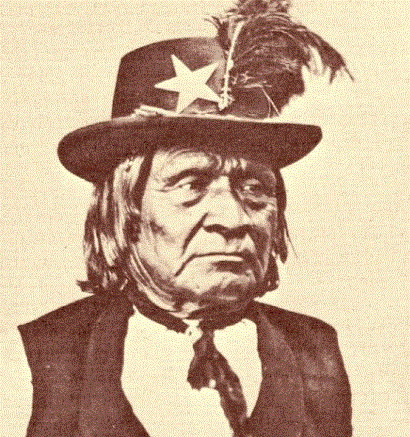Famous Comanche
Historical Comanche Leaders:
Amorous Man – (Comanche, Pahayoko “aunt copulate”) (c. late 1780s – p. 1852) was a Civil Chief of the Penateka band of the Comanche Indians.
Big Red Meat (Piarʉ Ekarʉhkapʉ) – (c. 1820/1825 – January 1, 1875) was a Nokoni Comanche war chief.
Black Horse (Tu-uh-ku-mah ?–ca. 1900 Cache, Oklahoma) Black Horse was a Comanche war chief who was elevated to second chief in Quanah Parker’s Quahadi band of Comanche, after the death of Chief Bull Bear in 1874.
Buffalo Hump (Potsʉnakwahipʉ) (c. 1800-c. 1865/1870) – war chief and later head chief of the Penateka Band.
Chief Bull Bear –
Carne Muerto – A War Chief of the Quahadi tribe of Comanche, son of Santa Anna.
Chief Huupi-pahati, a.k.a. “Tall Tree” –
Horseback (Tʉhʉyakwahipʉ) (c. 1805/1810-c. 1888) – chief of the Nokoni band
Iron Jacket (Puhihwikwasu’u) (c. 1790-1858) – war chief and later head chief of the Quahadi band; father of Peta Nocona
Isatai (c. 1840–c. 1890) – warrior and medicine man of the Quahadi band, who brought the Sun Dance to the Comanche
Mo’o-wai (“Pushing aside” or “Pushing-in-the-middle”), aka “Shaking Hand” – chief of the Kotsoteka
Peta Nocona (Lone Wanderer) (c. 1820-c. 1864) – chief of the Quahadi band in Texas; father of Quanah Parker
Old Owl – (Mupitsukupʉ) (late 1780s–1849) – Penateka chief
Cynthia Ann Parker – A white captive who was captured as a young girl and became the wife of a Comanche chief. She was the mother of Quanah Parker. Many years later she was “rescued” by whites, and spent the rest of her life trying to get back to her Comanche people. Also see Cynthia Ann Parker Bio
Quanah Parker (Comanche kwana “smell, odor”) (ca. 1845 or 1852 – February 23, 1911) – One of the last Comanche chiefs of the Quahadi (“Antelope-eaters”), related also to the Nokoni band (“Wanderers” or “Travellers”), his mother’s people. His mother was Cynthia Ann Parker, a white captive. Quanna Parker was a founder of the Native American Church, and last chief of the Comanche.
White Parker (1887–1956) – son of Quanah Parker and a Methodist missionary.
Quenah-evah, a.k.a. “Eagle Drink” – Principle Chief who replaced Huupi-pahati after his death, possibly after the smallpox and cholera epidemics of 1849.
Santa Anna – (c. 1800-c. 1849) – War chief of the Penateka Band. A leader of Comanche resistance to Anglo settlement in Texas, especially during the period following the Council House Fight. He was the father of Carne Muerto.
Spirit Talker (Mukwooru) (c. 1780-1840) – Penateka chief and medicine man
Ten Bears (Pawʉʉrasʉmʉnunʉ) (c. 1790–1872) – chief of the Ketahto and later of the Yamparika band, great orator.
Tosahwi (White Knife) (c. 1805/1810-c. 1878/1880) – chief of the Penateka band.
Other Comanche People of Note:
Gil Birmingham (born 1953) – actor, Into the West
Blackbear Bosin, also known as Tsate Kongia (June 5, 1921 – August 9, 1980) – Kiowa-Comanche sculptor and painter
Charles Chibitty (1921–2005) – World War II Comanche code talker
LaDonna Harris (born 1931) – political activist and founder of Americans for Indian Opportunity
Lotsee Patterson (born 1931) – librarian, educator, and founder of the American Indian Library Association
Tom Mauchahty-Ware – Kiowa-Comanche musician
Sonny Nevaquaya – Native American flute-player
Sanapia (1895–1984) – medicine woman
Paul Chaat Smith – author, curator
George “Comanche Boy” Tahdooahnippah (born 1978) – professional boxer and NABC super middleweight champion
Rudy Youngblood (born 1982) – actor, starred in Apocalypto, not enrolled in the tribe. Youngblood is of Comanche, Cree, and Yaqui ancestry.
Article Index:
Tosahwi (White Knife) was a peaceful Penateka Comanche chief during the last decade of the Indian Wars.
Born: 1805/1810
Died: 1878/1880 at Anadarko Agency
 Tosahwi was one of the signers of the Treaty of Tehuacana Creek in Juanuary 1846, along with Pah-hayoco (“Amorous Man”), Old Owl (Mupitsukupʉ), Buffalo Hump (Potsʉnakwahipʉ), Isa-viah (“Yellow Wolf”), Santa Anna, Ketumse, and Asa-havey (“Wolf’s Road”, “Starry Road” or “Milky Way”).
Tosahwi was one of the signers of the Treaty of Tehuacana Creek in Juanuary 1846, along with Pah-hayoco (“Amorous Man”), Old Owl (Mupitsukupʉ), Buffalo Hump (Potsʉnakwahipʉ), Isa-viah (“Yellow Wolf”), Santa Anna, Ketumse, and Asa-havey (“Wolf’s Road”, “Starry Road” or “Milky Way”).
After 1849, with the death of Old Owl and Santa Anna, the departure of Pah-hayoco (now settled, during his last years, as resident guest among the Kotsoteka band), and Buffalo Hump’s becoming first chief and Isa-viah’s becoming second chief of the Penateka Comanches, he became one of the most important chiefs of the Penateka band.
In 1861, along with the Yamparika head chief Ten Bears (Pawʉʉrasʉmʉnuna), the Nokoni chief Horseback (Tʉhʉyakwahipʉ) and his Penateka comrade Asa-havey, Tosahwi went to Fort Cobb where they met C.S.A. Gen. Albert Pike, and the Comanche chiefs, including the Nokoni head chief Quenah-evah, (“Eagle Drink”), and the Kotsoteka chief Mow-way, and signed for an allegiance with the Confederation.
As a leader of the Penateka band, Tosahwi engaged in many raids in the American Southwest in the 1860s, but in 1867-1868, he was the first Comanche leader to surrender to the military at Fort Cobb in the Indian Territory, and, on this occasion, he is reported to have had an alleged exchange with Philip Sheridan where Sheridan purportedly stated “The only good Indians I ever saw were dead”, which was sometimes rephrased as “the only good Indian is a dead Indian.” Sheridan denied ever making either statement.
He signed as head chief of the Penateka at the Medicine Lodge Treaty, and accepted to sit in a reservation, under the control of Fort Cobb, having the Comanche Agency in the Eureka Valley. He managed to keep out the Penateka preventing their involvement in the Red River War in 1873-1874.

